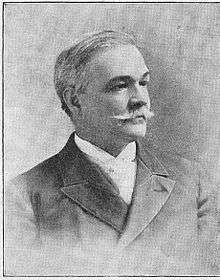Nicanor Bolet Peraza
| Nicanor Bolet Peraza | |
|---|---|
 | |
| Born |
June 4, 1838 Caracas, Venezuela |
| Died |
March 24, 1906 (aged 67) New York City, United States |
| Nationality | Venezuelan |
| Notable works | Historia de un guante (1892) |
Nicanor Bolet Peraza (June 4, 1838 – March 25, 1906)[1] was a Venezuelan writer and politician.
Early life
Peraza was born in Caracas, Venezuela in 1838 to Nicanor Bolet Poleo y Egaña and María del Pilar Peraza Sosa.[2] He was one of six siblings and was the younger brother of the artist Ramon Bolet Peraza. At the age of one Peraza and his family relocated to Barcelona, Venezuela where his father would establish a printing press. This press would soon work both Ramon and Nicanor who would both go on to pursue interests in publication. Eventually Nicanor and Ramon established their first magazine, El Oasis.[3] Nicanor would be pushed away from publishing due to the declaration of the Federal War in 1859. At the age of 21, he enlisted in the federal army and fought in Venezuela's largest war since Spanish independence. Following the Federalist victory in 1863, Peraza would return to his birthplace of Caracas and work together with his brother to establish the Rotary Museum Illustrated, a political newspaper.[4] [5]Peraza would also soon marry María Perfecta Monagas Marrero and have four children.[2]
Political career
Having earned the rank of Brigadier General during the war, Peraza took an active role in national policy. He was appointed as a representative in congress while simultaneously maintaining his work in publication which largely focused on national opinion.[4] After the former vice-president, Antonio Guzman Blanco, had assumed the presidency in 1870, Peraza had initially been supportive of the new regime in hopes of peace, prosperity, and stability, yet soon grew bitter of Guzman's abuse of power. When Guzman was ousted in 1877 and Francisco Linares Alcántara rose to power, Peraza had embraced the new policy and quickly became one of Alcántara's strongest supporters which would eventually earn him a position as secretary of the Ministry of the Interior and Justice. This prompted Peraza's push to pursue generous and reconciliation policies towards Venezuelan exiles from the war. Due to Alcántara's untimely death in 1878, Antonio Guzman would retake control of the government. To counter Guzman's regime, Peraza frequently published newspapers that censured and criticized Guzman and his government. Subsequent targeting of opposition by Guzman would cause Peraza to exile himself to the United States in 1880 along with his family for the rest of his life.[6][7]
In exile
Peraza had faced some difficulty adapting to the American lifestyle upon his arrival to New York. He was forced to leave a respectable position as a politician and had to start a new life at the age of 42. Despite this, Peraza had managed to find success through his prior pursuits in publication. After being exiled he managed to find himself as the writer/editor of two respectable magazines: New York Illustrated and The Three Americas. Peraza had also frequently collaborated with other prominent Hispanic figures such as fellow countryman Juan Antonio Pérez Bonalde and Cuban poet José Martí. In 1888, the current president of Venezuela, Juan Pablo Rojas Paúl, had recognized Peraza's prominence as a Venezuelan writer and appointed him Plenipotentiary and Envoy Extraordinary to Washington. After a successful career in Washington, Peraza returned to New York to resume his work in publication. In 1895, Peraza was invited to attend the 100th anniversary of José Gregorio Monagas, a past Venezuelan president who fought for emancipation and had been Peraza's father-in-law. After accepting the invitation from the current president, Peraza had returned to his native land in order take part in the commemorations. Though he was moved to excitement about experiencing his homeland once more, he ultimately decided to return to New York. Peraza died 11 years later at the age of 67, just a few months shy of his birthday.[6]
Works
References
- ↑ "New-York tribune. (New York [N.Y.]) 1866-1924, June 30, 1906, Image 7". 1906-06-30. p. 7. ISSN 1941-0646. Retrieved 2018-05-01.
- 1 2 "General de Brigada Nicanor Bolet y Peraza". geni_family_tree. Retrieved 2018-05-01.
- ↑ MCNBiografias.com. "Bolet Peraza, Nicanor (1838-1906). » MCNBiografias.com". www.mcnbiografias.com (in Spanish). Retrieved 2018-05-10.
- 1 2 "Biografia de Nicanor Bolet Peraza". www.biografiasyvidas.com (in Spanish). Retrieved 2018-05-01.
- ↑ MCNBiografias.com. "Bolet Peraza, Nicanor (1838-1906). » MCNBiografias.com". www.mcnbiografias.com (in Spanish). Retrieved 2018-05-10.
- 1 2 Cano, J.R. (2018-05-01). "The Biography of Nicanor Bolet Peraza". TheBiography. Retrieved 2018-05-01.
- ↑ MCNBiografias.com. "Bolet Peraza, Nicanor (1838-1906). » MCNBiografias.com". www.mcnbiografias.com (in Spanish). Retrieved 2018-05-10.
- 1 2 3 "Bolet Peraza, Nicanor (1838–1906) | The Greenwood Encyclopedia of Latino Literature - Credo Reference". search.credoreference.com. Retrieved 2018-05-01.